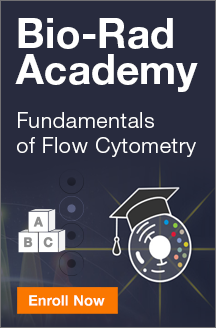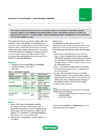-
US | en
- Contact and Support
- Technical Support
- Antibody Protocols
- Flow Cytometry
- Cell Activation Protocols
- Unprimed T cell activation - pharmacologic methods

Unprimed T Cell Activation - Pharmacologic Methods
This method provides a general procedure for activating T cells prior to staining for intracellular cytokines, activation markers or cell proliferation using pharmacologic means. These include agents such as PMA and ionomycin, PHA and Con A. All blood samples must be collected into heparin anticoagulant as EDTA will interfere with the cell stimulation process.
This protocol is for use for use with the majority of Bio-Rad reagents. In some cases specific recommendations are provided on product datasheets, and these methods should always be used in conjunction with the product and batch specific information provided with each vial. A certain level of technical skill and immunological knowledge is required for the successful design and implementation of these techniques; these are guidelines only and may need to be adjusted for particular applications.
Reagents
- Phosphate buffered saline (PBS, cat. #BUF036A)
- Stimulation reagents - see Table 1
- Cell media
- Table 1. Stimulation reagents.
Reagent |
Cells |
Concentration |
Mode of Action |
|---|---|---|---|
|
Human, mouse, rat |
500x |
Mixture of PMA, ionomycin and Brefeldin A. Brefeldin A is a protein transport inhibitor that leads to an accumulation of cytokines in intracellular space |
|
|
Phorbol 12-myristate 13-acetate (PMA) |
Human, mouse, rat |
1-10 ng/ml |
Activation of protein kinase C, use with ionomycin |
|
Ionomycin |
Human, mouse, rat |
200-500 ng/ml |
Calcium ionophore, use with PMA |
|
Phytohaemagglutinin (PHA) |
Human, mouse, rat |
1-5 µg/ml |
Indirect TCR cross-linking, requires antigen presenting cells |
|
Concanavalin A (Con A) |
Mouse, rat |
1-10 µg/ml |
Indirect TCR cross-linking, requires antigen presenting cells |
Methods
1. Isolate PBMC using the appropriate methods, for example, for human peripheral blood refer to protocol FC2 Preparation of Human Peripheral Blood Mononuclear Cells, for mouse and rat spleen refer to protocol FC3 Preparation of Peritoneal Macrophages, Bone Marrow, Thymus and Spleen Cells.
2. Resuspend in the appropriate media and adjust to 1 x 106 cells/ml.
Optional step
For proliferation studies using CytoTrack™ Cell Proliferation Assay or CFSE, incubate cells with the dye following the recommended protocol, or see protocol FC18 Measuring Cell Proliferation Using Cell Permeable Dyes.
3. Add the pharmacological agent to each well. See Table 1 for list of reagents and final concentrations. This will differ depending on the species and origins of your cells and the experimental requirements. Add an equivalent amount of PBS or media to a tube to act as an unstimulated control.
4. Add 1 x 105 cells and incubate cells in a humidified 37oC, 5% CO2 incubator for 6–72 hrs depending on experimental needs.
5. Harvest cells and perform surface or intracellular staining as required. Note: cytokine staining requires golgi inhibitors such as brefeldin A and monensin, see Cell Stimulation Reagent (with Brefeldin A) (BUF077A) or protocol FC9 Direct Immunofluoresence Staining of Intracellular Cytokines in Blood for more details.
6. Acquire by flow cytometry.
Notes
Appropriate controls should be carried out for flow cytometry, consider including the following:
- Unstained cells (should always be included to monitor autofluorescence)
- Unstimulated control

